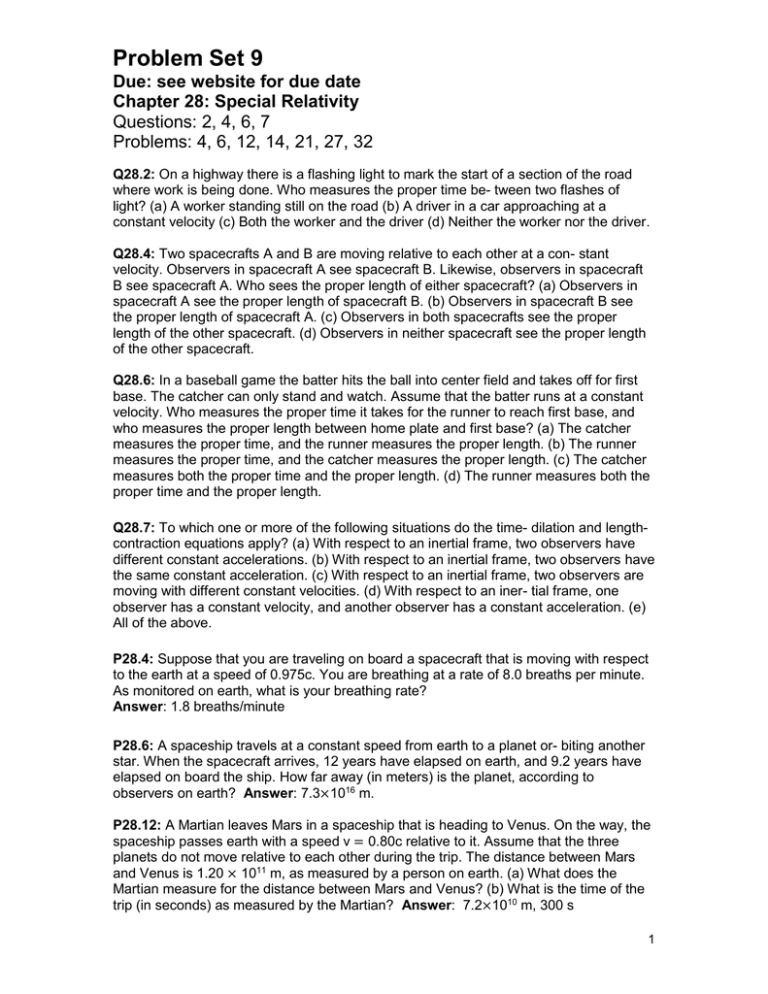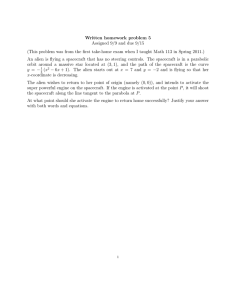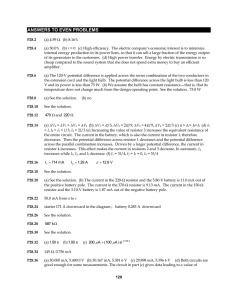Problem Set 9 Due: see website for due date
advertisement

Problem Set 9 Due: see website for due date Chapter 28: Special Relativity Questions: 2, 4, 6, 7 Problems: 4, 6, 12, 14, 21, 27, 32 Q28.2: On a highway there is a flashing light to mark the start of a section of the road where work is being done. Who measures the proper time be- tween two flashes of light? (a) A worker standing still on the road (b) A driver in a car approaching at a constant velocity (c) Both the worker and the driver (d) Neither the worker nor the driver. Q28.4: Two spacecrafts A and B are moving relative to each other at a con- stant velocity. Observers in spacecraft A see spacecraft B. Likewise, observers in spacecraft B see spacecraft A. Who sees the proper length of either spacecraft? (a) Observers in spacecraft A see the proper length of spacecraft B. (b) Observers in spacecraft B see the proper length of spacecraft A. (c) Observers in both spacecrafts see the proper length of the other spacecraft. (d) Observers in neither spacecraft see the proper length of the other spacecraft. Q28.6: In a baseball game the batter hits the ball into center field and takes off for first base. The catcher can only stand and watch. Assume that the batter runs at a constant velocity. Who measures the proper time it takes for the runner to reach first base, and who measures the proper length between home plate and first base? (a) The catcher measures the proper time, and the runner measures the proper length. (b) The runner measures the proper time, and the catcher measures the proper length. (c) The catcher measures both the proper time and the proper length. (d) The runner measures both the proper time and the proper length. Q28.7: To which one or more of the following situations do the time- dilation and lengthcontraction equations apply? (a) With respect to an inertial frame, two observers have different constant accelerations. (b) With respect to an inertial frame, two observers have the same constant acceleration. (c) With respect to an inertial frame, two observers are moving with different constant velocities. (d) With respect to an iner- tial frame, one observer has a constant velocity, and another observer has a constant acceleration. (e) All of the above. P28.4: Suppose that you are traveling on board a spacecraft that is moving with respect to the earth at a speed of 0.975c. You are breathing at a rate of 8.0 breaths per minute. As monitored on earth, what is your breathing rate? Answer: 1.8 breaths/minute P28.6: A spaceship travels at a constant speed from earth to a planet or- biting another star. When the spacecraft arrives, 12 years have elapsed on earth, and 9.2 years have elapsed on board the ship. How far away (in meters) is the planet, according to observers on earth? Answer: 7.3×1016 m. P28.12: A Martian leaves Mars in a spaceship that is heading to Venus. On the way, the spaceship passes earth with a speed v = 0.80c relative to it. Assume that the three planets do not move relative to each other during the trip. The distance between Mars and Venus is 1.20 × 1011 m, as measured by a person on earth. (a) What does the Martian measure for the distance between Mars and Venus? (b) What is the time of the trip (in seconds) as measured by the Martian? Answer: 7.2×1010 m, 300 s 1 P28.14: An unstable high-energy particle is created in the laboratory, and it moves at a speed of 0.990c. Relative to a stationary reference frame fixed to the laboratory, the particle travels a distance of 1.05×10-3 m before disintegrating. What are (a) the proper distance and (b) the distance measured by a hypothetical person traveling with the particle? Determine the particle’s (c) proper lifetime and (d) its dilated lifetime. Answer: 1.05 mm, 14.8 mm, 4.98×10-13s, 3.53×10-12s P28.21: A woman is 1.6 m tall and has a mass of 55 kg. She moves past an observer with the direction of the motion parallel to her height. The observer measures her relativistic momentum to have a magnitude of 2.0×1010 kg? m/s. What does the observer measure for her height? Answer: 1.0 m Hint: use momentum to determine v first. P28.27: Suppose that one gallon of gasoline produces 1.1×108 J of energy, and this energy is sufficient to operate a car for twenty miles. An aspirin tablet has a mass of 325 mg. If the aspirin could be converted completely into thermal energy, how many miles could the car go on a single tablet? Answer: 5.3×106 mi Solution The mass m of the aspirin is related to its rest energy E0 by Equation 28.5, E0 = mc2. Since it requires 1.1 108 J to operate the car for twenty miles, we can calculate the number of miles that the car can go on the energy that is equivalent to the mass of one tablet. We begin by converting the mass m from milligrams (mg) to kilograms (kg): 6 325 mg 1000 mg 1000 g 325 10 kg 1g 1 kg The number N of miles the car can go on one aspirin tablet is N mc 2 1.1 10 J / 20.0 mi 8 325 106 kg 3.0 108 m/s 1.1 10 J / 20.0 mi 8 2 5.3 106 mi P28.32: An electron is accelerated from rest through a potential difference that has a magnitude of 2.40 3 107 V. The mass of the electron is 9.11×10-31 kg, and the negative charge of the electron has a magnitude of 1.60×10-19 C. (a) What is the relativistic kinetic energy (in joules) of the electron? (b) What is the speed of the electron? Express your answer as a multiple of c, the speed of light in a vacuum. Answer: 3.84×10-12 J, 0.999781c 2





